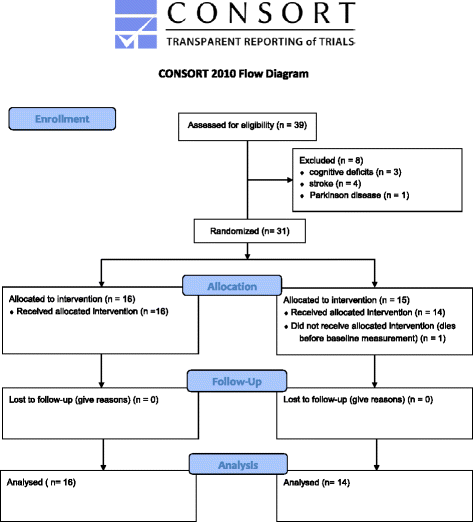Sensory-motor training targeting motor dysfunction and muscle weakness in long-term care elderly combined with motivational strategies: a single blind randomized controlled study
- PMID: 27239241
- PMCID: PMC4884400
- DOI: 10.1186/s11556-016-0164-0
Sensory-motor training targeting motor dysfunction and muscle weakness in long-term care elderly combined with motivational strategies: a single blind randomized controlled study
Abstract
Background: This study evaluated the effects of a combined innovative training regime consisting of stochastic resonance whole-body vibration (SR-WBV) and a dance video game (DVG) on physical performance and muscle strength in long-term-care dwelling elderly.
Methods: Thirthy long-term-care elderly were randomly allocated to an intervention group (IG; n = 16) receiving combined SR-WBV training and DVG, or a sham group (SG; n = 14). IG performed five sets one minute of SR-WBV, with one minute rest between sets (base frequency 3 Hz up to 6 Hz, Noise 4) during the first five weeks on three days per week. From week five to eight a DVG was added to SR-WBV for IG on three days per week. SG performed a five-set SR-WBV program (1 Hz, Noise 1) lasting five times one minute, with one minute rest in between, three days a week. From week five to eight stepping exercises on a trampoline were added on three days per week.
Primary outcome: Short physical performance battery (SPPB). Secondary outcome: isometric maximal voluntary contraction (IMVC), and sub phases of IMVC (Fsub), isometric rate of force development (IRFD) and sub time phases of IRFD (IRFDsub) were measured at baseline, after four and eight weeks. ANOVA with repeated measures was used for analyses of time and interaction effects and MANOVA determined between group intervention effects.
Results: Between group effects revealed significant effects on the SPPB primary outcome after four weeks F(1, 27) = 6.17; p = 0.02) and after eight weeks F(1,27) = 11.8; p = 0.002). Secondary muscle function related outcome showed significant between group effects in IG on IRFD, Fsub 30 ms, 100 ms, 200 ms and IRFDsub 0-30 ms, 0-50 ms, 0-100 ms and 100-200 ms compared to SG (all p < 0.05).
Conclusions: Eight weeks SR-WBV and DVG intervention improved lower extremity physical function and muscle strength compared to a sham intervention in long-term-care elderly. SR-WBV and DVG seems to be effective as a training regime for skilling up in long-term-care elderly.
Keywords: Long-term care; Motivational strategies; Motor dysfunction; Muscle weakness; Sensory-motor training.
Figures
Similar articles
-
Combining Stochastic Resonance Vibration With Exergaming for Motor-Cognitive Training in Long-Term Care; A Sham-Control Randomized Controlled Pilot Trial.Front Med (Lausanne). 2020 Nov 30;7:507155. doi: 10.3389/fmed.2020.507155. eCollection 2020. Front Med (Lausanne). 2020. PMID: 33330519 Free PMC article.
-
Immediate effects after stochastic resonance whole-body vibration on physical performance on frail elderly for skilling-up training: a blind cross-over randomised pilot study.Aging Clin Exp Res. 2014 Oct;26(5):519-27. doi: 10.1007/s40520-014-0212-4. Epub 2014 Apr 4. Aging Clin Exp Res. 2014. PMID: 24700493 Clinical Trial.
-
Effect of stochastic resonance whole body vibration on functional performance in the frail elderly: A pilot study.Arch Gerontol Geriatr. 2014 Sep-Oct;59(2):305-11. doi: 10.1016/j.archger.2014.06.005. Epub 2014 Jul 9. Arch Gerontol Geriatr. 2014. PMID: 25042993 Clinical Trial.
-
Long-Term Effects of Whole-Body Vibration on Human Gait: A Systematic Review and Meta-Analysis.Front Neurol. 2019 Jun 19;10:627. doi: 10.3389/fneur.2019.00627. eCollection 2019. Front Neurol. 2019. PMID: 31316447 Free PMC article.
-
Effects of long-term whole-body vibration training on mobility in patients with multiple sclerosis: A meta-analysis of randomized controlled trials.J Neurol Sci. 2015 Nov 15;358(1-2):31-7. doi: 10.1016/j.jns.2015.09.357. Epub 2015 Sep 25. J Neurol Sci. 2015. PMID: 26421830 Review.
Cited by
-
Holistic physical exercise training improves physical literacy among physically inactive adults: a pilot intervention study.BMC Public Health. 2019 Apr 11;19(1):393. doi: 10.1186/s12889-019-6719-z. BMC Public Health. 2019. PMID: 30971234 Free PMC article. Clinical Trial.
-
Effectiveness and Acceptability of e- and m-Health Interventions to Promote Physical Activity and Prevent Falls in Nursing Homes-A Systematic Review.Front Physiol. 2022 May 20;13:894397. doi: 10.3389/fphys.2022.894397. eCollection 2022. Front Physiol. 2022. PMID: 35669573 Free PMC article.
-
Effects of stochastic resonance whole-body vibration on sensorimotor function in elderly individuals-A systematic review.Front Sports Act Living. 2023 Apr 17;5:1083617. doi: 10.3389/fspor.2023.1083617. eCollection 2023. Front Sports Act Living. 2023. PMID: 37139302 Free PMC article. Review.
-
Sarcopenia interventions in long-term care facilities targeting sedentary behaviour and physical inactivity: A systematic review.J Cachexia Sarcopenia Muscle. 2024 Dec;15(6):2208-2233. doi: 10.1002/jcsm.13576. Epub 2024 Sep 18. J Cachexia Sarcopenia Muscle. 2024. PMID: 39291586 Free PMC article.
-
Combining Stochastic Resonance Vibration With Exergaming for Motor-Cognitive Training in Long-Term Care; A Sham-Control Randomized Controlled Pilot Trial.Front Med (Lausanne). 2020 Nov 30;7:507155. doi: 10.3389/fmed.2020.507155. eCollection 2020. Front Med (Lausanne). 2020. PMID: 33330519 Free PMC article.
References
-
- Rikli RE, Jones CJ. Development and validation of a functional fitness test for community-residing older adults. J Aging Phys Activ. 1999;7(2):129–161.
-
- Leveille SG, Wagner EH, Davis C, Grothaus L, Wallace J, LoGerfo M, Kent D. Preventing disability and managing chronic illness in frail older adults: a randomized trial of a community-based partnership with primar care. J Am Geriatr Soc. 1998;46(10):1191–8. doi: 10.1111/j.1532-5415.1998.tb04533.x. - DOI - PubMed
LinkOut - more resources
Full Text Sources
Other Literature Sources
Medical
Research Materials
Miscellaneous



